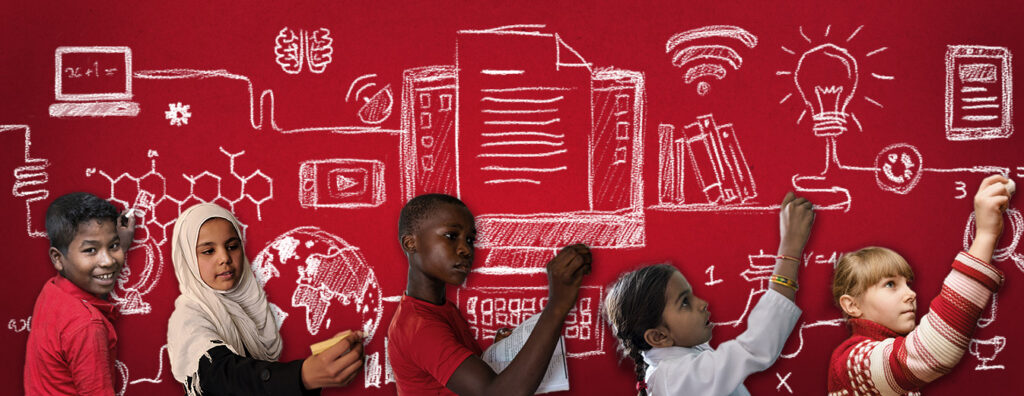 The Transforming Education Summit of world leaders was held on 19th September 2022 at the UN Headquarters in New York during the 77th session of the UN General Assembly (UNGA). This was the first time that education has been a focal point of UNGA.
The Transforming Education Summit of world leaders was held on 19th September 2022 at the UN Headquarters in New York during the 77th session of the UN General Assembly (UNGA). This was the first time that education has been a focal point of UNGA.
The Transforming Education Summit (TES) took place after more than two years of massive disruption in learning, brought on by the COVID-19 pandemic, and a deepening global crisis in education. It was a key initiative of Our Common Agenda and a milestone in the mobilisation of the international education community for achieving Sustainable Development Goal 4: Ensure inclusive and equitable quality education and promote lifelong learning opportunities for all.
Leonardo Garnier, Special Adviser for the Summit explained:
“This Summit is so important: it is not a technical, but a political summit. It is a moment of truth for heads of states and leaders of nations and global institutions, where we must commit ourselves not just to accelerate the pace, but actually to reimagine and transform education systems because only through such a radical transformation will we be able to really accomplish the goals of inclusive, quality education for all.”
Our Common Agenda
The UN Secretary-General António Guterres released his ‘Our Common Agenda’ report at UNGA a year before in September 2021. The report envisages getting the world back on track to deliver for people and planet by accelerating implementation of existing agreements, including Agenda 2030 and action on the Sustainable Development Goals (SDGs). However, meeting the ambitions of the SDGs now requires urgent and collaborative transformation. The Summit of the Future: multilateral solutions for a better tomorrow will be held at the UN in September 2024 – a ‘once-in-a-generation opportunity’ to enhance cooperation on critical challenges.

By providing a vision for the future of global cooperation and effective multilateralism to deal with future challenges, the report outlines possible solutions to the gaps and greater risks that have emerged in the world since 2015. It recognises that humanity is at a critical historical juncture with ‘threatening prospects of probable futures.’ We face an existential dilemma between pursuing an unsustainable path or radically changing course – ‘a breakdown or a breakthrough.’
We need to transform the future.
And to transform the future, we need to transform education. Because education is key to humanity changing course. As the foundation for human development, it is also the basis to transforming and shaping alternative possible futures and to rebalancing humanity’s relationship with the living planet.
Yet current educational models, approaches, and practices will not help us change course and transform the future. The very purposes of education need to be revisited and education needs to be renewed if it is to transform the future. We need to reimagine what a transformed education sector in the 21st century should look like.
The Our Common Agenda report identified the need to create a common vision for transforming education, skills training, and lifelong learning. The Secretary-General undertook to convene a Summit on Transforming Education in September 2022 to spotlight the urgency to determine the transformation required and accelerate progress towards achievement of SDG 4. The Summit marked halfway to the deadline to meet the SDGs.
The Futures of Education Commission – forging a ‘new social contract’ for education
In late 2021, the International Commission on the Futures of Education, convened by UNESCO, published a global report on its work, entitled ‘Reimagining our futures together: A new social contract for education’.
The report was informed by a two-year global consultation. As a key building block for the Transforming Education Summit, it proposes a vision for the renewal of education – described as a new social contract for education. This is based on the two foundational principles of the right to quality education, and a commitment to education ‘as a public endeavour and a common good’.
Looking ahead to 2050 and beyond, it also examines the role of education in shaping the future. It maps the current state of education around the world, from the perspectives of equality, justice and sustainability:
“Education must aim to unite us around collective endeavours and provide the knowledge, science, and innovation needed to shape sustainable futures for all anchored in social, economic, and environmental justice. It must redress past injustices while preparing us for environmental, technological, and social changes on the horizon.”
International Commission on the Futures of Education, 2021
The global crisis in education
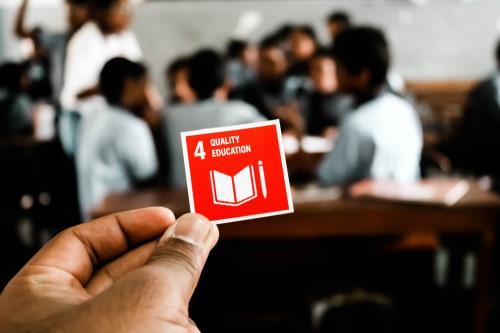
The Transforming Education Summit was also convened in response to the global crisis in education.
While the international community is committed to ensuring that all children and youth are granted their right to education, in fact countries are moving ever farther away from achieving this goal. The COVID-19 crisis reversed the progress already made towards the education-related SDGs and they are now badly off track.
The learning crisis – of equity and inclusion, quality and relevance – is having a devastating impact on the futures of children and youth worldwide and, if unaddressed, its negative impacts will be felt for decades to come.
A crisis of equity and inclusion:
Millions of children, young people and adults are denied their right to education, which limits their life potential and ability to achieve other rights and freedoms. At least 763 million young people and adults lack basic literacy skills, and 244 million children and young people are still out-of-school.
The COVID-19 pandemic exacerbated pre-existing educational inequalities and challenges, disproportionally affecting marginalised populations. It affected 1.6 billion children by school closures for an average of 20 weeks, peaking to 80 weeks in some cases. About 24 million students may never return to school. The knock-on financial effects include estimates of students at risk of losing US$ 21 trillion in potential lifetime earnings, which represents 17% of today’s global GDP.
A crisis of quality:
All children should be able to read, write and perform basic mathematics as well as given other core skills. Yet many children, including those who are enrolled in school, are not even acquiring basic literacy skills. In 2019 the share of 10-year-old children who could not read and understand a simple text was already high at 57 percent in low- and middle-income countries. But by 2022 this had increased to a concerning 70 percent.
A fundamental crisis of relevance:
Worldwide, education systems have profound structural flaws. Education provided through contemporary systems is no longer fit for purpose. Education systems need to be modernised and connected, making learning more student-centred, dynamic, inclusive and collaborative. The transformational potential of teaching and learning for longer-term change needs to be unlocked.
UNESCO Pre-Summit to the TES, June 2022
Comprehensive national consultations were organised and country reports filed in advance of the Transforming Education Summit. These sought to assess the impact of COVID-19; identify concrete recommendations going forward; promote a reimagining of education (by finding innovative solutions); and encourage countries to make a bold commitment to education.
Over 130 countries submitted national statements of commitment to transform education. David Sengeh, Minister of Basic and Senior Secondary Education, Sierra Leone, shared his overview of the Pre-Summit and country reports process in a blog post for UNESCO in July 2022.
In June 2022 a Pre-Summit to the TES was held at UNESCO’s headquarters in Paris. More than 150 ministers of education and nearly 2,000 participants gathered, including many young activists, experts, civil society leaders and the private sector.
They expressed their determination to shift from reforming to transforming education from the ground up. Indeed, as UN Deputy Secretary-General Amina J. Mohammed put it, building back education better would not make the cut – the obligation was to build forward differently.
“Together, we can make the Transforming Education Summit not just a gathering about education, but a turning point for education; and a hefty boost for SDG 4.” H.E. Amina J. Mohammed, United Nations Deputy Secretary-General
Critical issues in Education
The Transforming Education Summit also built on the work of the Global Partnership for Education on replenishment of the global fund for education and the establishment of the Global Education Cooperation Mechanism.
The lead-up preparations for the Summit identified the key areas needing urgent attention. These were guided by the 2030 Agenda and its education-related goals and targets, specifically SDG 4.
At the same time, the pre-summit preparatory work provided an opportunity to rethink and reimagine the purpose, content and delivery modes of education. In other words, to consider how to transform education toward a more peaceful, inclusive and sustainable future for humanity and the planet.
Critical issues in education were identified, including equity, the education obstacles faced by girls and young women, the transition from education to employment, and the promotion of lifelong learning and reskilling. The crucial role of the world’s teachers as partners in transforming schools, colleges and universities was recognised, and the need to value them.
Other high priority areas included the lack of adequate financing for national education transformation efforts and the urgent need for digital inclusivity to ensure that all schools are connected to the internet by 2030.
Summit Thematic Action Tracks
Building on these themes, the Transforming Education Summit developed 5 Thematic Action Tracks, identified as the key levers which have the greatest transformational potential. Countries were encouraged to focus on at least one of the five tracks:
Track 1: Inclusive, equitable, safe and healthy schools (inclusivity)
Track 2: Learning and skills for life, work and sustainable development (quality of learning)
Track 3: Teachers, teaching and the teaching profession (teacher’s role)
Track 4: Digital learning and transformation (digital connectivity)
Track 5: Financing of education (adequate and innovative financing)
The Action Tracks seek to mobilise new commitments, by highlighting policy interventions that work, and leveraging existing initiatives and partnerships, including those that emerged in response to the COVID-19 pandemic. They are open to all stakeholders, including member states, donors, policymakers, civil society groups, young people, teachers’ networks, education advocates, academia, the private sector and philanthropies.
What happened at the Summit?
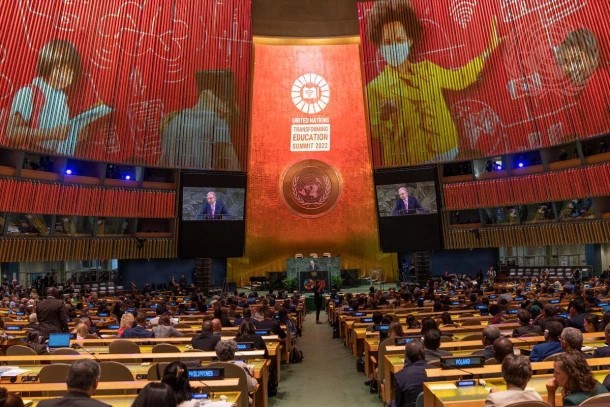
The September 2022 Summit aimed to elevate education to the top of the global political agenda by persuading global leaders to commit to the Transforming Education Agenda between now and 2030. The Summit also aimed to reimagine education systems for the world of today and tomorrow and to take stock of efforts to recover pandemic-related learning losses.
The Summit was structured to ‘mobilise political ambition, action, solidarity, and solution-finding’ with a view to revitalising national and global efforts to achieve SDG 4:
16 September: Mobilisation Day
The Mobilisation Day was youth-led and youth-organised and resulted in a Summit Youth Declaration to support the transformation of education across the world. The day involved the full participation of a wide range of stakeholders, including youth, teachers, civil society and member state delegations. Youth recommendations were conveyed to decision and policymakers.
17 September: Solutions Day
The Solutions Day provided a platform for partners to mobilise support to launch or scale up initiatives that will contribute to transforming education. Member States and stakeholders co-organised sessions and events connected to the Summit Thematic Action tracks.
19 September: Leaders Day
Leaders Day was dedicated to the presentation of National Statements of Commitment by Heads of State and Government in the form of Leaders’ Roundtables. Leaders Day also featured presentation of the Summit Youth Declaration and the UN Secretary-General’s Vision Statement for Transforming Education.
New Global Initiatives – Calls to Action
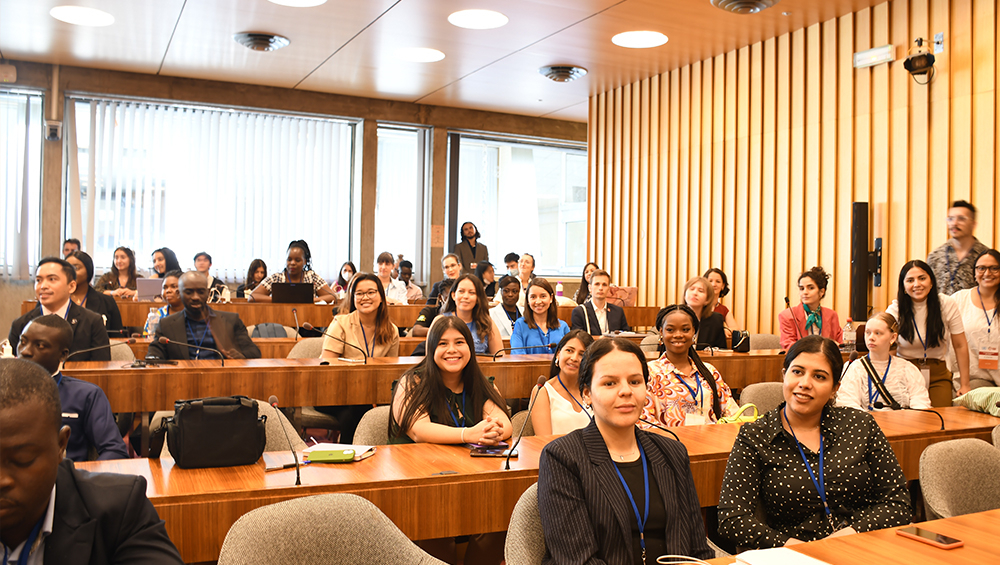 Seven new Global Initiatives and Calls to Action were launched at the Summit, each one aiming to mobilise solutions to accelerate national and global efforts to achieve SDG4 and transform education:
Seven new Global Initiatives and Calls to Action were launched at the Summit, each one aiming to mobilise solutions to accelerate national and global efforts to achieve SDG4 and transform education:
- Greening Education to get every learner climate-ready;
- Connecting every child and young person to digital solutions;
- Addressing the crisis in foundational learning among young learners;
- Transforming education systems to enable all crisis-affected children and youth to access inclusive, quality, safe learning opportunities and continuity of education;
- Advancing gender equality and girls’ and women’s empowerment;
- Transforming the financing of education by investing more, more equitably, more efficiently, more innovatively;
- Empowering young people to be effective leaders in reshaping education.
Outcomes of the Summit
A full Report on the Transforming Education Summit was published in January 2023. In summary, the outcomes of the Summit were:
- Statements of National Commitment to Transform Education submitted by 133 Member States, complemented by the personal participation of 65 Heads of State and Government (HOS/Gs) at the Summit itself.
- A Vision Statement of the UN Secretary General, ‘Transforming Education: An urgent political imperative for our collective future’, issued to provide a set of principles for education in the 21st century. This was formally submitted as an input to intergovernmental negotiations on the future of education as part of the preparations for the September 2024 UN Summit of the Future.
- Launch of Global initiatives to mobilise support for national efforts on major thematic priorities: education in crisis situations, the learning crisis, greening education, advancing gender equality and girls’ and women’s empowerment through education and public digital learning. Additional proposals emerging from the Summit process included the establishment of a High Level Panel on the Teaching Profession (underway), a Global Youth Initiative (launched on the International Day of Education – 24 January 2023), and a fresh push for disability inclusion in education.
- Launch of an ambitious Call to Action on Transforming Education Financing, making a strengthened case for more equitable and efficient investment in education; establishment of the International Financing Facility for Education (IFFEd) to potentially mobilise USD 10 billion in funding for lower-middle income countries in the years to come. Watch the video explaining the IFF for Education.
- Strengthening of a youth-led global movement for transforming education, supported by the dynamism of civil society, teachers, and other partners. The Youth Declaration on Transforming Education is a centrepiece of this effort.
- Methylin er vs strattera
- Propranolol and hydrochlorothiazide
- District of Columbia proscar shipping
- Bepreve with discount
- Protonix anxiety
- Mobic without prescription
- Where to buy epivir in Saskatchewan
- Klonopin serequel celexa precautions
- Pennsylvania shipping avalide
- Buy nortriptyline from Hawaii
To ensure accountability and effective follow-up of the Summit the SDG4 High-Level Steering Committee, coordinated by UNESCO and co-chaired by Sierra Leone, is playing a key role. The Steering Committee is tasked with providing support to strengthen global, regional, and national level cooperation and enable the alignment of action between education partners. The UNESCO Institute for Statistics and the Global Education Monitoring Report also continue their mandate for SDG 4 monitoring and reporting.
Assessment
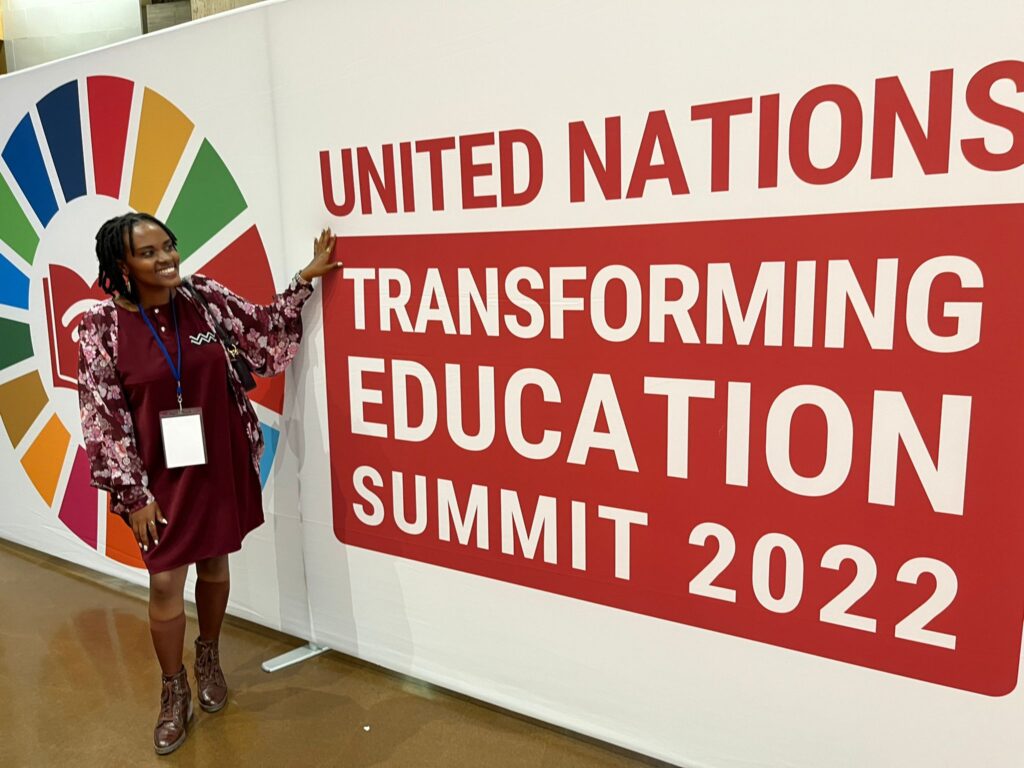
In advance of the TES, expectations in many quarters were low – that it would be a ‘talking shop’, mainly because education is largely a domestic affair. Some commentators have assessed that the result was largely that, as predicted.
However, many of the presentations by UN leaders and heads of state did create an inspirational tone that suggested much consensus on the urgency of addressing the educational crisis.
Nevertheless, there was little sign of anything ‘transforming’. Indeed, there was very little discussion either in the discussion papers or at the Summit of what transformation in education means and how it may be different from reform.
There was some disappointment with the Secretary-General’s Transforming Education Vision Statement. Kevin Watkins tweeted:
“This is honestly beyond embarrassing – the summit was an opportunity to deliver some practical action backed by international cooperation. Instead, we have a (mercifully short) blah, blah script of already agreed principles.”
Writing on UNESCO’s website, Sobhi Tawil and Charlène Camille attempt to provide some critical perspectives on the Transforming Education Summit, and what ‘renewing education to transform the future’ means.
For some analysis of the Summit discussion papers, an in-advance Blog Post on the Centre for Global Development (CGD) website attempted to provide pointers to what some of the issues were going to be and where some of the decisions needed to be taken to make for transformation.
This was followed up by a further Blog Post published on the CGD’s website on 28th September 2022 which undertook an analysis of the education priorities emanating from the national consultations.
More recently in July 2023, Education International published a review of national statements of commitment to assess the outcomes of the Summit. Their summary is as follows:
‘This analysis shows that there was no topic on which every country made a meaningful commitment at the Transforming Education Summit. In fact, many National Statements of Commitment can be far more accurately characterised as descriptions of the state of the art, rather than statements portraying actual commitments for educational transformation. Furthermore, many of the commitments seem to be ‘re-commitments’ as they do not seem to differ from previous targets set by these countries. Therefore, it seems there is much to be done to mobilise significant action for the transformation of education.’
A research report from Dr Gale T C Rigobert has compiled the main collective conclusions and proposed recommendations for transforming the education sector in the sub-region of the Eastern Caribbean.
Commonwealth Action
At the Commonwealth Education Ministers Action Group (CEMAG) and Commonwealth Accelerated Development Mechanism for Education (CADME), convened over 11-12 May in Marlborough House, ministers and senior officials received briefings on the Transforming Education Summit (TES). These global developments provided the backdrop to their discussions and decisions, including formation of a number of Ministerial Action Groups to take forward some of the TES Thematic Tracks and Global Initiatives/Calls to Action in a Commonwealth context. A CCfE report on these Commonwealth meetings can be found here.
Next Steps
The Transforming Education Summit has set the direction of travel for education with the issuing of the UN Secretary General’s Vision Statement. Future Global Education Meetings and the national SDG4 benchmarking process will steer matters to the next level. Finally, the UN Summit of the Future in 2024 will provide a further opportunity to take forward progress.
Compiled by Helen Jones, Communications Secretary
